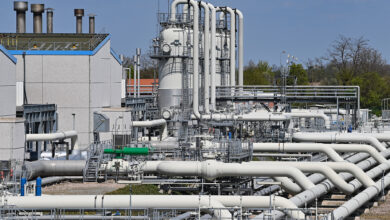We already know that the United Nations Environmental Programme (UNEP) has designated the Nile Delta one region of the world that stands to be most affected by possible rising sea-levels due to global climate change. Farmers and scientists both agree that the soil has reached alarming degrees of salinization due to sea water seeping into the water-table and the use of inorganic fertiliser after the building of the High Dam. Moreover, the National Authority for Remote Sensing(NARSS) has warned that unchecked urbanization would wipe out arable land in the delta within 100 to 120 years.
Indeed this upside down state of affairs is worthy of the term 'Destruction Phase'.
The UNEP report discusses the potential for 0.50m and 1.00m water rises by the year 2100, which would be accompanied by exponentially increased footprints of disaster.
Dr. Farouk al-Baz, head of Boston University’s Remote Sensing Lab and former Science Adviser to President Sadat tells us these projections are somewhat accurate. “All these projections are built on models of climate change which are uncertain. Most experts believe that during this century about half a meter of sea level rise is reasonable…So, we can plan on half a meter, and calculate for one meter just in case.”
Plan. And how ready are we for such a change?
A report by the OECD has questioned the lack of a coordinated response, arguing that “while a committee for Integrated Coastal Zone Management (ICZM) has been established, it has not been very active."
There are many Egyptian scientists at work on the Nile Delta’s vulnerabilities like Dr. Mohamed al-Raey, Environment Adviser to the Arab Academy of Science & Technology who prepared a presentation on the projected effects of sea level rise on the delta for various organizations including the United Nations International Strategy for Disaster Reduction (UNISDR). But there is no central body that processes this data and informs policy. Maybe the fact that we can’t really see the effects of climate change has left our government slow to act.
Dr. al-Baz points out that rising sea levels would be “very slow and imperceptible; we would not even see it or recognize that it is happening.” He notes that “cities such as Alexandria would remain [relatively] unaffected, because it sits atop a rocky plateau. Low areas at the two mouths of the Nile River–Rashid and Ras El-Barr–would be places to notice the submersion most.”
Recently concerns have been raised to save the delta, some calling for a 240km long dam along the coast to prevent a rising sea inundating the delta. Dr. al-Baz, however, questions this. “Wave breakers would be helpful only if the area is of reasonable size. The total length of the Delta coastline is vast. It would be best to replace the potentially lost land somewhere else on either side of the Delta.”
Already there is talk is of adaptive measures, and managed migration.
Another problem facing the idea of a dam along the shoreline is water-table salinity. Underground reservoirs have not been replenished after the completion of the High Dam in Aswan, and so sea water has seeped in, dramatically increasing soil salinity. According to the UNEP/GRID Ardenal report a dam along the coast would actually exacerbate the problem of salinated water from the Mediterranean seeping in.
Very confusing, but then the delta is not known to be a simple place. It turns out that saving the delta from climate change and soil salinity is only addressing part of the problem.
Population growth, wrong market policy on farm produce, and the fact that the delta’s land has been free from floods over the last 46 years have led to the inexorable destruction of cultivable land in the name of urban expansion. Dr. Hamdy al-Gamily, director of the Geoinformatics Centre at the Kuwait Institute for Scientific Research and formerly with NARSS calculated that between 1984 and 2000 we lost between 0.5 and 1 percent of the delta’s cultivable land per year.
“The needed time to demolish the delta is about 100-120 years maximum, if the urban growth rate continues like the last 20 years. This is not a long time, and we must take action,” says al-Gamily.
To give these numbers some context, out of a total area of 25,000 km2, we stand to lose between 1800 and 4500 km2 of crop land due to climate change by the year 2100. Urban expansion will claim between 12,500 to 25,000 m2 of the delta in the same time. It is over five times more dangerous to crop land than climate change, and threatens the entire delta, as opposed to a portion of it.
Without a coordinated interdisciplinary approach to inform and implement policy on a sustainable Nile delta, we risk the consequences of irrelevant solutions. As witnessed over the last 3000 years, any disaster mitigation model must take into consideration shoreline erosion, land subsidence, storm surge vulnerability, sea level rise, soil salinity and, now, urban expansion.
Not all is bad news though.
Dr. Farouk al-Baz believes there is also something to be gained from climate change. “Global warming would increase the evaporation of water in equatorial seas and this would increase rainfall…in the whole of the Arab desert belt,” he says. Of course he also warns of an increase in the hazards of flash floods.
Throughout the Nile Delta's turbulent multi-millennia history, irony has been no stranger. With every lost opportunity, be it silted branch, expanded lagoon or sunken city, one or more opportunities have been recognised and gained by its people, who despite the seemingly disastrous region they chose to settle and subsequently produced one of history’s more wondrous civilizations.
Charles Lyell, one of the ‘fathers’ of geological thought in the early to mid-1800’s, proposed that the "present is the key to understanding the past." In this case, Jean-Daniel Stanley, oceanographer and director of the Deltas-Global Change Program at the Smithsonian reverses the principle. “It is equally useful to recognize that our understanding of past events will help us understand, and hopefully at times, help predict the present and future…”



